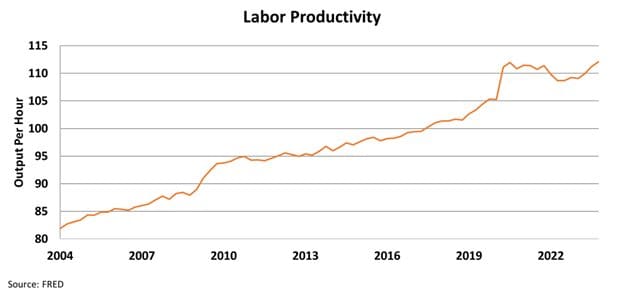The pandemic triggered a period of economic hardship, but the economy rebounded quickly thanks to a surge in labor productivity. In 2023, early adoption of AI continued to boost productivity and fuel stock market growth. In today’s FA Alpha Daily, we explore how AI is influencing labor productivity and the stock market, while also highlighting a potential risk on the horizon.
FA Alpha Daily:
Monday Macro
Powered by Valens Research
The beginning of the pandemic in early 2020 was accompanied by a period of unprecedented economic turbulence…
While lockdowns officially started in March 2020, the worst economic effects started showing up in the following few months.
For instance, as service businesses like restaurants and movie theaters completely shut down, a lot of that didn’t show up in unemployment data until April.
The U.S. unemployment rate was 4.4% in March 2020, and 14.7% the following month.
And after the first full quarter, companies started publishing their first pandemic-era results. Shockingly, corporate America looked fine. If anything, it looked like folks working from home helped make the economy look stronger
Economists looked to data like labor productivity, which measures the country’s total economic output divided by the number of hours worked. Productivity surged about 20% year-over-year to an all-time high.
That’s a huge reason why both the economy and the stock market rallied so fast after the initial panic. Over the long-term, the stock market tends to follow labor productivity closely.
Through 2021, labor productivity stayed strong. Folks were still working well from home, and pretty much the rest of the economy opened back up.
That drove the U.S. economy to grow by 5.9%, its best year since the 1980s, and it drove the S&P 500 to rally by 29%.
2022 was a different story… a mix of folks heading back to the office and rising interest rates forced productivity back down.
While 2023 was only the early innings for artificial intelligence (“AI”) adoption, it seems to already be making a difference.
Despite all our warnings that a wave of defaults is on the horizon, early investments in AI seem to be helping labor productivity.
Productivity increased in each quarter in 2023, and it reached an all-time high in the fourth quarter.
Take a look…


AI is doing what it promised to do. It’s helping make workers more efficient.
And over the last year, that’s what investors paid attention to. AI companies like the “Magnificent Seven” have driven most of the market’s gains since 2023 began.
AI is still in its early innings, which means we haven’t even begun to understand all the ways it’ll make our economy more efficient.
However, AI cannot save us from what’s right ahead of us. Beneath the surface, companies are still struggling to deal with their debts as interest rates remain high.
We haven’t seen a wave of defaults… yet. It’s unlikely that AI is going to save companies that are near distress.
AI will help drive the next bull market… it won’t prevent a recession. This is yet another reason we’re bullish for the U.S. stock market over the next decade-plus. However, don’t let that distract you from the risk that’s right in front of us.
Companies are going to struggle with defaults, and a wave of bankruptcies is bound to slow down recent labor productivity gains.
Keep focused, because investor sentiment can switch quickly.
Best regards,
Joel Litman & Rob Spivey
Chief Investment Strategist &
Director of Research
at Valens Research
To see our best macro insights, become an FA Alpha and get access to FA Alpha Pulse.
